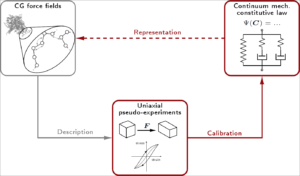Continuum mechanical constitutive modeling
Continuum mechanical constitutive models
In partitioned-domain multiscale simulations of polymers, the constitutive model used in the continuum has to coincide at least partly with the mechanical behavior of the particle-based domain. Under small deformations, hyperelastic constitutive models are accurate enough. However, under larger deformations, polymers can exhibit viscous or plastic behavior simultaneously, which requires a more sophisticated constitutive model that has to be derived from multiple MD simulations with different loading cases.

Fig. 1: Material characterization based on numerical pseudo-experiments [1]
Compared to experiments, MD simulations can access the evolution of microscopic structures during deformation, providing insights to interpret the mechanisms behind the complex mechanical behavior of glassy polymers. The main point is to find appropriate quantities to characterize the microscopic structures that have primary influences on the macroscopic response subjected to deformation. Here, we focus on the mechanisms of yielding, strain softening, and strain hardening of glassy polymers.
[1] Ries M., Possart G., Steinmann P., Pfaller S., “Extensive CGMD simulations of atactic PS providing pseudo experimental data to calibrate nonlinear inelastic continuum mechanical constitutive laws”, Polymers 11 (2019), 1824.
Milestones
- A phenomenological viscoelastic-viscoplastic model at intermediate deformation:
Zhao, W.; Ries, M.; Steinmann, P.; Pfaller, S.: A viscoelastic-viscoplastic constitutive model for glassy polymers informed by molecular dynamics simulations. International Journal of Solids and Structures, 111071 (2021). http://doi:https://doi.org/10.1016/j.ijsolstr.2021.111071. - Time-temperature correlations at large strains:
Zhao, W.; Xiao, R.; Steinmann, P.; Pfaller, S.: Time–temperature correlations of amorphous thermoplastics at large strains based on molecular dynamics simulations. Mechanics of Materials, 104926 (2024). https://doi.org/10.1016/j.mechmat.2024.104926. - A steady-state constitutive model for rate- and temperature-dependent strain hardening:
Zhao, W.; Steinmann, P.; Pfaller, S.:Modeling steady state rate-and temperature-dependent strain hardening behavior of glassy polymers. Mechanics of Materials, 105044 (2024). https://doi.org/10.1016/j.mechmat.2024.105044.
